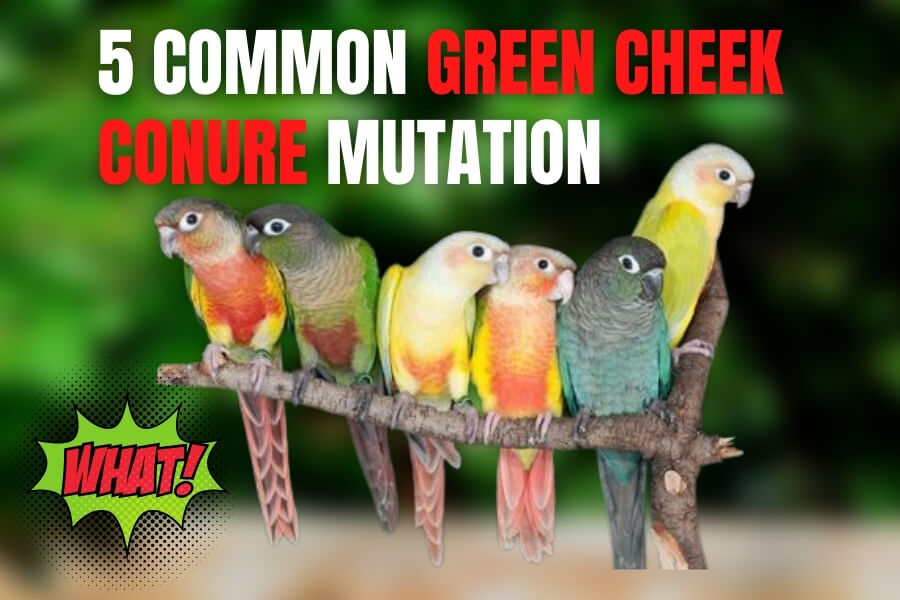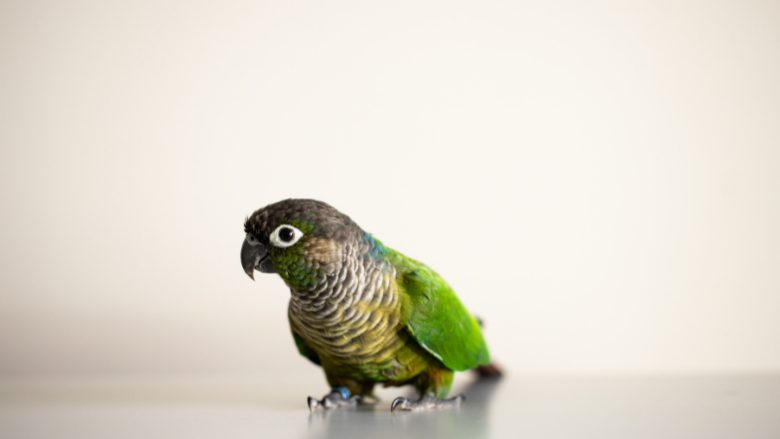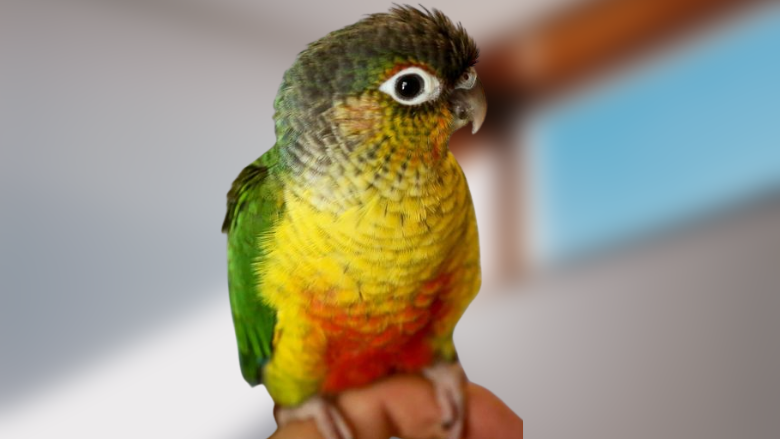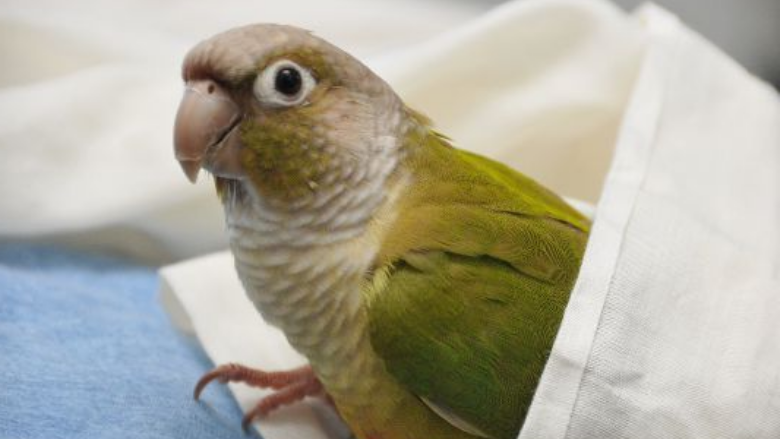Green cheek conures are one of the most popular pets in the world. They’re small, easy to care for, and come in many different colors!
But what if your green cheek conure is not quite like any other bird out there?
What if it has some unique coloration or markings that make it stand out from all the rest?
You might have a rare mutation! If you think this is your case, then follow along. This guide will teach you every mutation of these beautiful birds, how they look, their personalities, how cost they cost, and how to breed so that you can enjoy your green cheek even more than before.
What are the common green cheek conure mutations?
- Normal green cheek conure
- yellow sided green cheek
- Cinnamon green cheek conure
- Pineapple green cheek conure
- Turquoise green cheek conure
Did you know: Normal green cheek conures have been bred since the 1980s for the US pet trade, with the turquoise green cheek conure mutation being the newest.
#1: “Normal” green cheek conure mutation
Appearance: Normal green cheek conures typically have grey chest feathers; a green cheek conure’s wing feathers are basically bright green and red on their tail.
Unlike the yellow sided mutation, which we will discuss later, who has pink feet, the normal green cheeks have grey feet. Another indicator is that normal green cheeks do not have yellow markings on the chest.
Personality: The Normal green cheek conure and the yellow sided green cheek share similarity in personality. Both are fun-loving, affectionate clowns that love to cuddle in your sleeves or pockets. But the normal greek cheeks turn out to be a bit more naughty, constantly making their way into your cooking pots or food storage.
For those who do not have so much time and patience, the normal green cheeks are a good choice to get for your family. They’re independent enough that they can play by themselves in their cage or with you when needed- all without developing behavior problems from being left alone when you’re at work.
Unlike African greys, cockatoos or macaws require constant attention. Normal green cheeks are a better choice for those office people who are out to work five days a week.
Here is another variation of Normal green cheek:
Pied Normal Green Cheeks are a slight variation from normal green cheek conures. They have some yellow and red chest feathers, but not enough to be fully-fledged yellow sided green cheek.
Pied cheeks don’t cost much more than regular ones (they shouldn’t anyway), so there is no harm in getting one! Their personality is just as wonderful too–so if you’re looking for your new best friend that won’t break your wallet, get yourself a pied green cheek!
How to Breed: Normal green cheek conures are not hard to breed at all. Simply you’ll need to put a sexed male and normal female pair together, and that’s it—no need for any cross-breeding.
Cost: The market for green cheeks is constantly changing, and as a result, people are always looking to make sure they have the best price. You’d expect anywhere between $175-200 from private breeders. Pet stores will usually charge an extra 20% on top of that for profit.
#2: “Yellow Sided” green cheek conure mutation
Appearance: yellow sided green cheek mutations have green wings tipped with blue, a red tail, and black/grey head feathers. yellow sided mutations are, by all accounts, the same as green cheek conures except for one important detail: they have bright yellow and red feathers on the chest instead of grey ones.
Another good way to tell the difference between a yellow-sided green cheek conure and a normal one is to examine their feet. The normal ones have grey feet, while yellow-siders have red or pink feet.
yellow sided Personality: These guys are the same as the normals in personality–they love attention and will even cuddle with you for
In addition, yellow-sided green cheek conures will have pink feet, unlike the normal green cheek conures.
Personality: yellow sided green cheeks are a slightly more independent mutation than the normal green cheeks. They love to snuggle with humans, and after their nap, they will engage in much clowning around as their fun personality traits come flowing out again!
Most birds can’t handle well being left alone for long, but yellow sided conures are an exception. But it is worthing pointing out that yellow sided green cheeks are a bit snappy when they’re young.
One of the factors to consider when considering a yellow sided green cheek conure before purchasing is how to deal with the bitings.
How to Breed: The yellow-sided green cheek mutation is easy to breed, requiring no cross-breeding between species. All you need are a DNA sexed male and female pair of the same color and a dark nesting box, and you’re all set.
Cost: If you’re looking for a green cheek conure, consider the yellow sided mutation. They are rare and slightly more expensive than the normal green cheeks (costing $200-$250), but they have an even brighter color that is irresistible to look at!
#3: “Cinnamon” green cheek conure mutation
Appearance: The cinnamon green cheek conure has yellow-and-red chest feathers, a red tail, light pink feet, similar to the yellow sided conures.
What are key differences to tell them apart?
Cinnamon green cheek mutations have lighter green wings and lighter blue flight feathers than yellow sided or normal green cheeks.
What’s more than that?
Cinamon mutations have a tan/brown beak and head compared to the previous mutations I just mentioned, which have black/grey beaks and heads.
Personality: Cinnamon green cheek conures are typically more shy and cautious than yellow sided or normal green cheeks. They take time to warm up before becoming affectionate around you, but it is well worth your patience once they do!
How to Breed: Same as how you breed the previously mentioned mutations, except you’ll be putting two cinnamons together; no cross-breeding is needed. All you need is a nesting box, a healthy breeding diet, and a quieter space to make cinnamon conure clutches of eggs.
Cost: As of this writing, cinnamon conures can be found for sale starting at $175.
#4: “Pineapple” green cheek conure mutation
Appearance: The pineapple greek cheek has a self-explanatory name that reveals all the uniqueness: the distinct coloring of red and yellow feathers on their body makes it look like a ripe pineapple.
They appear to be rare and distinct from other mutations that this article previously touched on. You can easily tell a pineapple greek cheek from the other mutations: yellow and red chest color and pink feet.
Personality: Pineapple green cheek conures that result from breeding cinnamon green cheek conures with yellow-sided green cheeks are a perfect combination of both personalities. These mutations are more easily self-amused than yellow-sided green cheek conures. They tend to be shy around people but don’t take much time at all before warming up and becoming friendly.
How to Breed: Now, this is where things start to get a little tricky. Breeding pineapple conure mutations can be daunting.
Pineapple conures rely on recessive DNA in a yellow-sided/cinnamon green cheek conure pair. Breeders of pineapple conures have to look for specific, bright coloring in both the cinnamon and the yellow-sided green cheek.
Without knowing what to look for, cross breeders might end up with a slightly more yellowy cinnamon green cheek or a straight yellow-sided green cheek. Breeding pineapple/pineapple pairs doesn’t help much either.
Recessive and dominant DNA in pineapple green cheeks means breeders might end up with mostly red chicks or mostly yellow. Inexperienced breeders are better off buying a proven male/female pineapple green cheek pair – one that’s been proven to hatch true pineapple conure babies.
Cost: The rare, expensive mutation of pineapples is one of the most difficult to find. If you encounter a pineapple green cheek conure for sale, expect to pay $300-350 USD from private breeders and up to $400 at pet stores.
#5: “Turquoise” green cheek conure mutation
Appearance: Turquoise green cheeks are by far the rarest mutations among all. They have a lovely, muted sapphire wing hue and an off-white base, and a bright blue head with dull burgundy tail feathers.
Although turquoise green cheek may have a grey chest like normal mutation, it has sapphire feathers on the stomach. The turquoise green cheek conure is the only mutation with any sapphire feathers, making them unique!
Unlike other mutations with rainbow colors, turquoise green cheeks have quite a dull feather coloration scheme. But less is more —the rarest and most beautiful mutation of green cheek conures, turquoise green cheeks will not settle for anything less than dazzling!
Blue individuality: Turquoise green cheek conures are a new mutation that has been discovered in the 20th century. They have by far the most stand-offish and autonomous personalities of all other mutations, considering themselves feline royalty with plenty of dignity. Still, they can turn affectionate from time to time and happen to be one’s best friend if you’re lucky enough for them!
How to Breed: Turquoise blue-green cheeks are straightforward to breed: pick out the only show-caliber turquoise male/egg-producing green cheeks. Within this mutation, the brighter the bluish, the far better the result will be.
Cost: Blue-green cheek conures offered in US markets are relatively rare and relatively expensive. This genetic mutation will cost at least $400 in price from a trusted private breeder.





